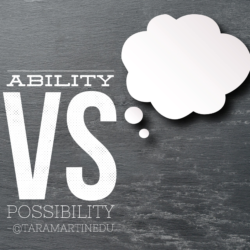
In the “Siri At Our Fingertips” world we live in, it seems a bit unnatural to ask open-ended questions. In fact, when I pose a question in the Google bar, I expect an answer, with a video explanation and a few links for me to discover all aspects of the solution. I think it’s safe to say, we want answers, and we want them quick. However, let’s consider how we might adjust our questioning skills to focus less on the ability to get the right answer and increase the variety of possible answers?
Before becoming an instructional coach, I was able to attend the Learning-Focused Relationships workshop with Bruce Wellman and Laura Lippman. We spent our three-day experience centered around the book Mentoring Matters. Bruce engaged us in a variety of activities to develop learning-focused relationships with our colleagues and students. Naturally, communicating was an essential piece of our workshop. On day one, he handed us a Meditational Mat to help guide our conversations. Over the course of the three days, we practiced interactions with each other using this mat to guide our discussions.
This experience changed the way I now engage in conversations. After the workshop, I decided to create a tool for teachers to use that might aid in asking more open-ended questions to their students. I adapted the idea of the Questioning Mat from the Meditational Mat by Bruce and Laura.
Why a Prescribed Questioning Mat?
The mat is simply a tool to practice developing well-crafted “thinking” questions that have a plethora of possibilities for solutions. When working with teachers, I introduce the Questioning Mat as a means to guide us until we are fluent.
In fact, we use scenarios they might encounter in the classroom and take turns crafting a question using the steps below. It feels a bit robotic at first, but when you hear the students’ responses, it changes the awkward feeling of developing the question, to one of excitement and wonderment at their thought process when answering it.
How To Use It
I print the 2-page Questioning Mat PDF front and back and distribute to the teachers. For professional development, I typically provide cards with classroom scenarios typed out and have the participants work in groups to form a question using the Questioning Mat that responds to the situation in the script. It’s quite an experience to shift the ability words to possibility words, but practice makes perfect.
If you try it, let me know what you think. How might you describe your ideal questioning strategy? Please share.
The 3-minute video below will explain how to use the mat. *Please stop the video at 3:09. The last part is repeated–“rookie-blogger” error. #RealEdu
Resources
Questioning Mat PDF
Video Link for explanation (Stop video at 3:09)
Blog Post: Ability vs Possibility
Application Scenarios to use with the Questioning Mat


